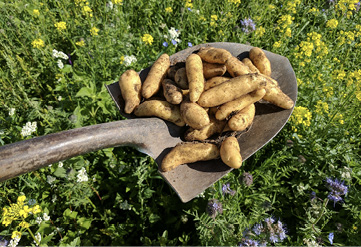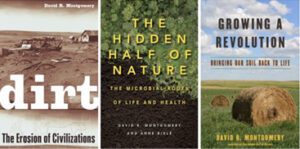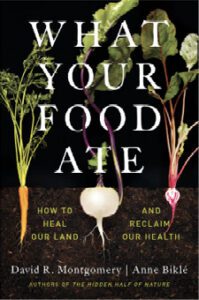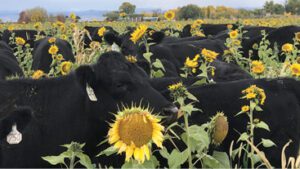
Article Written By: David Montgomery and Ann Bickle
Are we really what we eat? We think the old maxim doesn’t go far enough, for it doesn’t capture the importance of what your food ate—of how we raise our food. Our new book by that title explores the science and history that broadens what it means to be a farmer or eater in pursuit of health. From carrot to cow, the way farmers treat the soil affects what does—and doesn’t—make it into the human diet. In connecting soil health to crop health, livestock health, and human health a chain of causality links our health to that of land. At the root of it all is the role of soil life in nutrient cycling and spurring plants to make defensive and protective compounds that, in turn, benefit our health when we consume foods laden with them.
Controversy has long surrounded the question of nutritional differences between crops grown organically or conventionally, but assessing the role of soil health on nutrient density adds a new dimension related to the provisioning of micronutrients and phytochemicals that support human health. While organic practices are generally better for soil health than conventional ones, there is a wide range of organic (and conventional) practices. And under any system tillage done for long enough degrades soil organic matter—and soil health. Reframing our view of farming through the lens of soil health better connects the dots between soil health and human health.
In our previous books we wrote about the role of soil erosion and degradation in limiting the lifespan of past civilizations (Dirt) and how soil life runs the great underground bazaar that provisions crops with nutrients, especially the microbial partners whose metabolites form the foundation for the botanical world’s age-old health plan (The Hidden Half of Nature). Our most recent book (Growing a Revolution) related the experiences of regenerative farmers adopting practices that rebuilt soil organic matter and soil fertility and the science behind how bringing their soil back to life breathed new profitability into degraded fields. In What Your Food Ate we turn to links between soil health and human health exploring how regenerative farming practices can enhance the nutritional quality of our food through their effects on soil life.


We’ve long known that vitamins and minerals are necessary for good health in people. But over recent decades substantial evidence has accumulated that shows the importance of phytochemicals—compounds that plants make—in keeping chronic diseases at bay well into old age. In our new book we review the history of nutrition and highlight that defining nutrients as things necessary for growth and survival neglects the importance of other compounds that influence human health—those that modern farming practices reduced or altered in the plant and animal foods comprising the human diet. Chief among these are micronutrients, phytochemicals, and certain fats. Many serve anti-oxidant and anti-inflammatory roles in human physiology—as mediated by our gut microbiome.
The conventional view of crop nutrition is now being reframed around biologically-mediated plant-soil interactions. Most crops form partnerships with mycorrhizal fungi that help them acquire mineral micronutrients in exchange for root exudates. Soil life also stimulates the production of phytochemicals like carotenoids and polyphenols that serve protective roles in bolstering plant health—and serve as antioxidants and anti-inflammatory compounds when we eat them. Studies over the past several decades solidly established that soil life influences mineral uptake and phytochemical production in numerous crops.
Likewise, studies over the past several decades have shown that ruminants grazing a diverse diet of living plants in pastures have different fat profiles than their brethren fed a diet of seed-based feed products. In general, grasses and shrubs have higher content of omega-3 fats than do seeds (e.g., corn and soy), which tend to be far higher in omega-6 fats. So the amount of each and balance between these physiologically distinct fats in meat and dairy products depends on the diet of the animal producing them. Based on our literature review and some direct comparisons, ruminants, pigs, and chickens grazed on living plants have substantially higher omega-3 content and a better omega-6 to omega-3 ratio.

Photo By: Mark King
This all should not come as a total surprise. Early studies pointed to contrasting effects of soil organic matter and chemical fertilizers on soil life in influencing the composition of crops, yet understanding why lay beyond the scope of conventional thinking. While our review of prior studies found little evidence for significant differences between organic and conventional crops in terms of macronutrient composition, there appears to be substantial evidence for conventional crops consistently having higher pesticide levels and organic crops having higher phytochemical levels, particularly antioxidants and anti-inflammatory compounds.
As part of our research for What Your Food Ate we conducted 10 paired comparisons between regenerative and conventional farms and found that regenerative farms had higher soil organic matter levels, soil health scores, and levels of certain vitamins, minerals, and phytochemicals in harvested crops. All together our comparisons offer preliminary support for the conclusion that regenerative soil-building farming practices can enhance the nutritional profile of conventionally grown plant and animal foods and suggest soil health is an under appreciated influence on nutrient density, particularly for phytochemicals not conventionally considered nutrients but nonetheless relevant to chronic disease prevention. Likewise, regenerative grazing practices produced meat (beef and pork) with a better fatty acid profile than conventional brands.

Will a diet of regeneratively grown foods guarantee good health? Of course not, nothing can. But the way we raise our crops and livestock influences what makes it into our bodies, and regenerative farming practices that build soil fertility enhance the provisioning of compounds with known beneficial effects on human health—particularly for chronic diseases that increasingly plague the Westernized world. While it will prove challenging to rigorously link soil health and human health, our message in What Your Food Ate boils down to something quite simple. What’s good for the land is good for us too.
This article first appeared in the 8th Edition of Green Cover's Soil Health Resource Guide.
Also check out the 10th edition, our latest Soil Health Resource Guide, over 90 pages packed with scientific articles and fascinating stories from soil health experts, researchers, farmers, innovators, and more! All as our complimentary gift to you, a fellow soil health enthusiast!